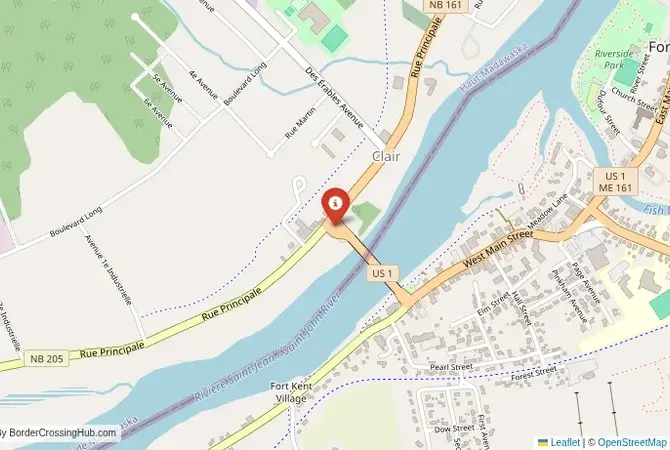
Approximate Border Location
Border Countries
- 🇺🇸United States
- 🇨🇦Canada
Border Cities
- 🇨🇦Clair, New Brunswick
- 🇺🇸Fort Kent, Maine
Wait Times
15-30 min for pedestrians/vehicles
Operating Hours
Open 8:00 AM – 6:00 PM
Crossing Types
Pedestrians, vehicles
Border Type
Land crossing via road
Peak Times
Mornings (7-10 AM)
Daily Crossings
~1500 travelers/vehicles
Currency Exchange
Available near Fort Kent (USD, CAD)
Safety Information
Generally safe, rural area
Languages Spoken
English
Accessibility Features
Ramps, assistance
About Clair, New Brunswick & Fort Kent, Maine
A Crossing in the Heart of Acadia
The border crossing connecting the town of Fort Kent, Maine, with Clair, New Brunswick, is a journey into the heart of a unique and resilient cultural region: the St. John Valley. This is not just a border; it is a bridge over the St. John River that connects two communities that share a common language, a common faith, and a common Acadian and French-Canadian heritage. To cross here is to travel from one part of a single, bilingual community to another, a passage that highlights the human consequences of a border drawn through a cohesive cultural landscape. It is a crossing defined by its magnificent international bridge and the deep, shared identity of the people who call this valley home.
Operational Details
This checkpoint connects Aroostook County, Maine, with Madawaska County, New Brunswick. It is a major regional crossing, open 24/7. The Clair-Fort Kent Bridge is a modern structure that spans the St. John River, connecting the centers of the two towns. The facility is designed to handle a significant volume of local and tourist traffic, as well as freight, particularly from the region’s vast timber industry. The crossing is a vital link for the local economy and for the many families that live on both sides of the river.
Before Crossing
Crossing borders gets messy sometimes, think political flare-ups or gates shutting fast. Good travel insurance is a must for handling doctor visits, trip disruptions, or security scares. Don’t get caught unprepared. To find a policy that’s got your back, check out reliable plans today for peace of mind.
A History of a Disputed Frontier
The history of this region is the history of the “Republic of Madawaska.” For decades in the early 19th century, the border in this region was hotly disputed between the United States and Great Britain, leading to the undeclared, bloodless “Aroostook War.” The Webster-Ashburton Treaty of 1842 finally settled the border, drawing it down the middle of the St. John River. This divided the French-speaking Acadian and Québécois communities that had settled the valley. Despite the international border, the region has maintained its unique, shared cultural identity, and French is still widely spoken on both sides of the river. The open border of today has allowed this community to function as a single, integrated region once again.
Border Crossing Procedure
The border crossing procedure is a professional and efficient process. You will approach a single, primary inspection booth for the country you are entering. You will need a valid passport or other approved travel document (such as a NEXUS card or an Enhanced Driver’s License). The border officer will ask you a series of questions about your citizenship, your destination, the purpose of your trip, and what goods you are bringing with you. Be prepared to declare all items. The process is generally straightforward and courteous, and the officers are accustomed to the constant flow of local, bilingual traffic.
The Surrounding Region: United States Side
On the US side, the crossing is in the town of Fort Kent. The town is home to a historic fort from the time of the Aroostook War, a University of Maine campus, and is the starting point of the Can-Am Crown International Sled Dog Race. It is also the northern terminus of U.S. Route 1, which runs all the way to Key West, Florida. The town is a hub for exploring the vast North Maine Woods, a paradise for hunting, fishing, and snowmobiling.
The Surrounding Region: Canada Side
On the Canadian side, the crossing is in the village of Clair, New Brunswick. The region is part of the “Republic of Madawaska,” and the nearby city of Edmundston is the main center of the francophone community in the province. The area is known for the New Brunswick Botanical Garden and the “Cycloparc,” a paved bicycle trail that runs along a former railway line. The region is a gateway to the beautiful forests and rivers of northern New Brunswick and the neighboring province of Quebec.
Practical Travel Information
Practical planning for this route is straightforward. The main road is well-maintained. The official currencies are the US Dollar (USD) in the United States and the Canadian Dollar (CAD) in Canada. Services are available in the towns on both sides of the border. Be aware of the customs limits for goods, particularly agricultural products like potatoes, which are a major local industry. The region is bilingual, so you will hear both English and French spoken on both sides of the border.
Final Considerations
The Fort Kent–Clair border crossing is a journey into the heart of Acadia. It is a busy, functional checkpoint that serves as a vital link for a unique and resilient bilingual community. It offers a passage through a beautiful landscape of forests and rivers and a region with a deep and fascinating history. For the traveler, it is a gateway to the vast wilderness of the North Maine Woods and the rich French-Canadian culture of New Brunswick. It is a border that is a testament to the enduring power of culture to transcend political divisions.
No reviews yet.
